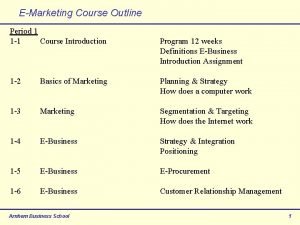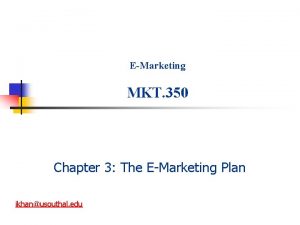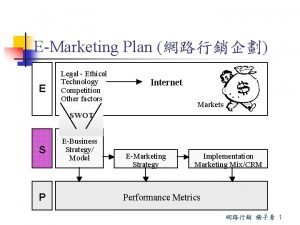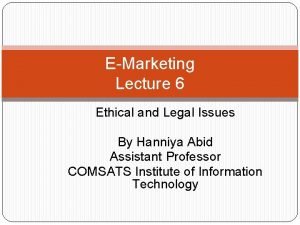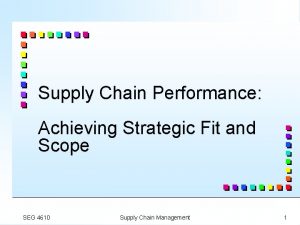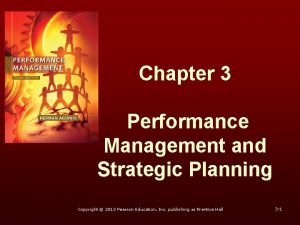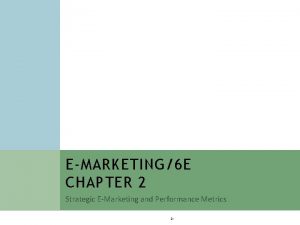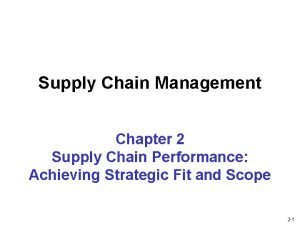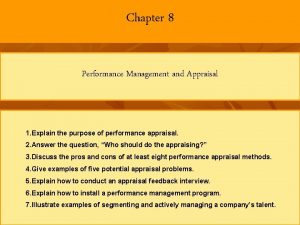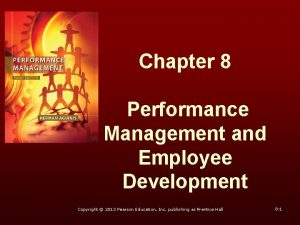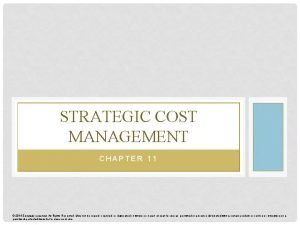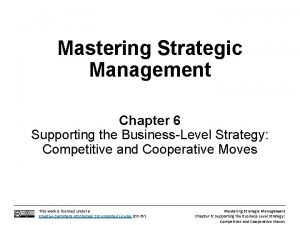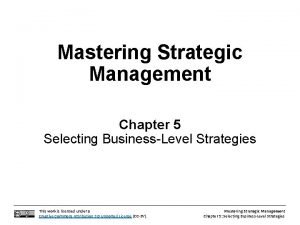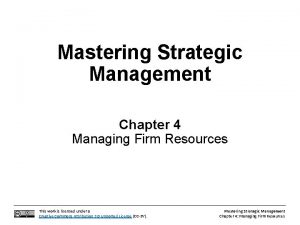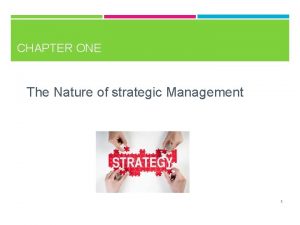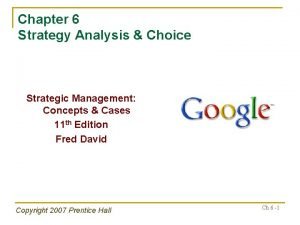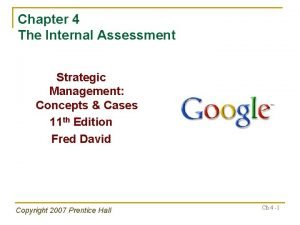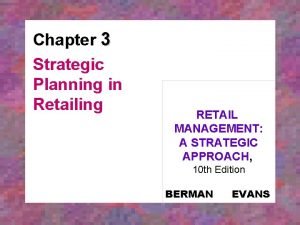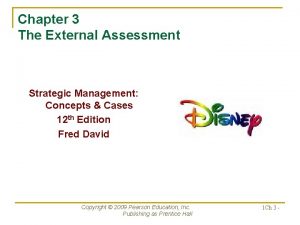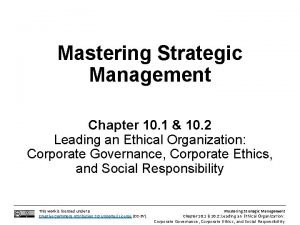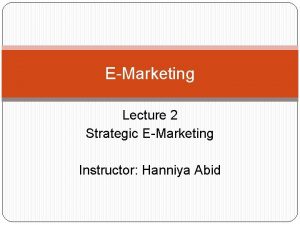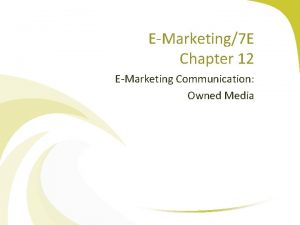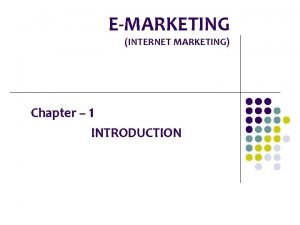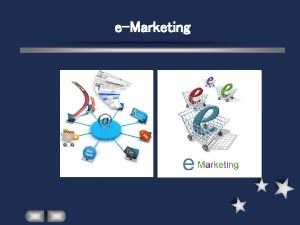EMarketing7 E Chapter 2 Strategic EMarketing and Performance











































- Slides: 43

E-Marketing/7 E Chapter 2 Strategic E-Marketing and Performance Metrics

Chapter 2 Objectives • After reading Chapter 2, you will be able to: – Explain the importance of strategic planning, strategy, e-business strategy, and e-marketing strategy. – Identify the main e-business models at the activity, business process, and enterprise levels. – Discuss the use of performance metrics and the Balanced Scorecard to measure e-business and emarketing performance. – Enumerate key performance metrics for social media communication. © 2014 Pearson Education, Inc. publishing as Prentice Hall 2 -2

The Amazon Story • Founded in 1995 as an online retailer. – Did not become profitable until Q 4 2001. – In 2011, generated $48. 1 billion in net sales, $631 million in net income. • Leveraged its competencies into different e-business models. – Core business is online retailing, “everything store. ” – Established e-commerce partnerships. – Developer services provider. – Content provider. – Created the first affiliate program. © 2014 Pearson Education, Inc. publishing as Prentice Hall 2 -3

The Amazon Story, cont. • Founder and CEO Jeff Bezos is not interested in expanding to the physical world. • Amazon’s success is based on selection, lower prices, better availability, innovative technology, and better product information. • Which of Amazon’s core competencies do you think will drive its strategy in the future? © 2014 Pearson Education, Inc. publishing as Prentice Hall 2 -4

Strategic Planning • The process of developing and maintaining a strategic fit between the organization’s goals and capabilities and its changing market opportunities. • Process identifies firm’s goals for – Growth How much can the company reasonably expect to grow in terms of revenues and how fast? – Competitive position How should the company position itself against other firms in the industry – Geographic scope Where should the company serve its customers, local or multinational? – Other objectives, such as industry, products, channels, etc. © 2014 Pearson Education, Inc. publishing as Prentice Hall 2 -5

ESP: Environment, Strategy, and Performance • The ESP model illustrates the relationships among environment, strategy, and performance. • A SWOT analysis of the business environment (E) leads to the development of strategy (S) and the measurement of performance (P). • Performance metrics are designed to evaluate effectiveness and efficiency of e-business and emarketing operations. © 2014 Pearson Education, Inc. publishing as Prentice Hall 2 -6

ESP model focuses on strategy and performance © 2014 Pearson Education, Inc. publishing as Prentice Hall 2 -7

Strategy • Strategy is the means to achieve a goal. • E-business strategy – Deploys enterprise resources to reach performance objectives and create competitive advantage. • E-marketing strategy – Capitalizes on information technology to reach specified objectives. © 2014 Pearson Education, Inc. publishing as Prentice Hall 2 -8

Business Models • A company will select one or more business models as strategies to accomplish enterprise goals. • An e-business model is a method by which the organization sustains itself in the long term using information technology, which includes its value proposition for partners and customers as well as its revenue streams. © 2014 Pearson Education, Inc. publishing as Prentice Hall 2 -9

SELECTING A BUSINESS MODEL • Components of business model selections: Customer value Scope Price Revenue sources Connected activities Implementation Capabilities Sustainability © 2014 Pearson Education, Inc. publishing as Prentice Hall 2 -10

Selecting E-Business Model • Customer value: Does the model create value through its product offerings that is differentiated in some way from that of its competitors? • Scope : Which markets does the company serve and are growing? • Price: Are the company's products priced to appeal to markets? • Revenue Sources : Where is money coming from? © 2014 Pearson Education, Inc. publishing as Prentice Hall 11

Selecting E-Business Model (contd. ) • Connected Activities: What activities will the company need to perform to create value described in the model? • Implementation: The company mus have the ability to actually make it happen, which involves the firm's systems, people, culture and so on. • Capabilities: Does the company have the resources (finance, core competencies, etc. ) to make the selected models work? • Sustainability: The e-business model is particularly appropriate if it can create competitive advantage over time. © 2014 Pearson Education, Inc. publishing as Prentice Hall 12

E- Marketing Contributes to the E-Business Model © 2014 Pearson Education, Inc. publishing as Prentice Hall 13

Level of Commitment to E-Business © 2014 Pearson Education, Inc. publishing as Prentice Hall 2 -14

Activity-Level E-Business Models 1. Online purchasing 2. Order processing 3. E-mail 4. Content publishing 5. Business intelligence (BI) 6. Online advertising and public relations (PR) 7. Online sales promotions 8. Pricing strategies 9. Social media communication 10. Search marketing © 2014 Pearson Education, Inc. publishing as Prentice Hall 2 -15

Activity Level E-Business Models • Online Purchasing : Company can use the Web to place orders with suppliers. Eg. Walmart created the automated order processing through the supply chain • Order Processing: This model occurs when online retailers automate internet transactions created by customers • E-mail : When organization send e-mail communicatios to stakeholder • Content Publishing: Companies create valuable content or services on their website • Business Intelligence: Refers to the low cost online gathering of primary and secondary information about competitors, markets, customers and other entities. © 2014 Pearson Education, Inc. publishing as Prentice Hall 16

Activity Level E-Business Models (contd. ) • Online advertising and public relations (PR): Advertising on someone's else Website or email • Online Sales Promotion: Companies use internet to send samples of digital products (e. g. music or software) or use of discount coupons such as Groupon. com • Pricing Strategies: With dynamic pricing, a company presents different prices to various groups of customers. • Social Media Communication: Company use FB pages, Twitter, blogs to engage and build relationships with customers and prospects. • Search Marketing: Getting found online or inbound marketing © 2014 Pearson Education, Inc. publishing as Prentice Hall 17

Business Process-Level E-Business Models Customer relationship management (CRM) Enterprise resource planning (ERP) Knowledge management Mass customization Supply chain management Crowdsourcing Community building Freemium Affiliate programs Location-based marketing Database marketing © 2014 Pearson Education, Inc. publishing as Prentice Hall 2 -18

Business Process -Level Business Models Customer relationship management (CRM) involves retaining and growing business and individual customers through strategies that ensure their satisfaction with the company and product. • Knowledge management a combination of a company's database contents, the technology used to create system, and the transformation of data into useful information and knowledge. • Supply chain management • Community building • © 2014 Pearson Education, Inc. publishing as Prentice Hall 2 -19

Business Process -Level Business Models (contd. ) • Supply chain management : involves coordination of the suppliers and distribution channel to deliver products more effectively and efficiently to customers. (e. g. Fed. Ex receive instructions to pickup product from a warehouse and deliver it to the customer) • Community building : companies build social media Web pages to draw groups of special-interest groups. • Affiliate programs : occur when companies put a link to someone else's retail Web site and earn commision. • Database marketing : involves collecting, analyzing and disseminating electronic information about customers, prospects and products to increase profits. © 2014 Pearson Education, Inc. publishing as Prentice Hall 20

Business Process -Level Business Models (contd. ) • Enterprise resource planning (ERP) : refers to back office system for order entry, purchasing, invoicing and inventory control. • Mass customization : refers to internet's unique ability to customize marketing mixes electronically and automatically to the individual level. • Crowdsourcing : is the practise of outsourcing ads and other tasks to people outside the organization. • Freemium : company offer basic product for free then provide upgraded versions for a fee. (e. g. software) • Location-based marketing: delivers local and relevant content to a user's mobile device using GPS technology. © 2014 Pearson Education, Inc. publishing as Prentice Hall 21

Enterprise-Level E-Business Models • • • E-commerce refers to online transactions: selling goods and services on the internet. Social commerce uses social media to facilitate online sales. Direct distribution is when manufacturers sell directly to consumers. Content sponsorship is a form of e-commerce in which companies sell advertising on their Web pages, You. Tube videos, or other online media. A portal is a point of entry to the internet that combines diverse content from many sources. © 2014 Pearson Education, Inc. publishing as Prentice Hall 2 -22

Enterprise-Level E-Business Models, cont. • Social network sites are those that bring users together to share interests and personal or professional profiles. • Online brokers are intermediaries who assist in the purchase negotiations without actually representing either buyers or sellers. • Manufacturer’s agents represent more than one seller. • Purchasing agents represent buyers. © 2014 Pearson Education, Inc. publishing as Prentice Hall 2 -23

Pure Play • Pure plays are businesses that began on the internet. – They represent the final level of the pyramid. • Pure plays face significant challenges. – They must compete as new brands. – They may need to take customers away from established businesses. • Some pure plays have redefined industries: Yahoo!, Google, Twitter, Flickr, and e. Bay. © 2014 Pearson Education, Inc. publishing as Prentice Hall 2 -24

Performance Metrics Inform Strategy • Performance metrics are specific measures designed to evaluate the effectiveness and efficiency of operations, online and offline. • Performance metrics: – Provide measurable outcomes. – Must be easy to understand use. – Must be actionable. – Can motivate employees to make decisions that lead to desired outcomes. © 2014 Pearson Education, Inc. publishing as Prentice Hall 2 -25

Web Analytics • Web analytics is the e-marketing term for the study of user behavior on Web pages. • Metrics measure activities such as: – Click throughs from advertising. – Page views. – Number of comments posted on a blog. – Number of fans on a company Facebook page. – Conversions to sales. © 2014 Pearson Education, Inc. publishing as Prentice Hall 2 -26

Data Collection • Data for Web analytics are collected in several ways: – Website server logs – Cookie files – Page tags – Geolocation © 2014 Pearson Education, Inc. publishing as Prentice Hall 2 -27

Metrics Used to Measure Internet Marketing Performance © 2014 Pearson Education, Inc. publishing as Prentice Hall 2 -28

The Balanced Scorecard • The Balanced Scorecard provides a framework for understanding e-marketing metrics. • The Balanced Scorecard provides 4 perspectives. – Customer perspective – Internal perspective – Learning and growth perspective – Financial perspective © 2014 Pearson Education, Inc. publishing as Prentice Hall 2 -29

The Balanced Scorecard: Customer Perspective • The customer perspective scorecard includes ways to measure goals such as customer satisfaction, engagement and retention. – Loyalty and satisfaction measures may include percentage of visitors who return to site, time between visits, and shopping cart abandonment. – Customer engagement could include the number of comments, photos or videos posted. • Exhibit 2. 7 provides a list of customer goals and measures. © 2014 Pearson Education, Inc. publishing as Prentice Hall 2 -30

Customer Perspective © 2014 Pearson Education, Inc. publishing as Prentice Hall 31

The Balanced Scorecard: Internal Perspectives • The Internal perspective includes ways to measure goals related to the quality of online services and measures for the entire supply chain. – Number of customers who use service – Number of complaints in social media – Amount of time to answer customer e-mail – Number of updates per day • Exhibit 2. 8 provides a list of internal goals and measures. © 2014 Pearson Education, Inc. publishing as Prentice Hall 2 -32

Internal Perspective © 2014 Pearson Education, Inc. publishing as Prentice Hall 33

The Balanced Scorecard: Learning and Growth Perspectives • The learning and growth perspective scorecard includes human resources, product innovation and continuous improvement of marketing processes. – Number of new service products to market – Number of customer complaints and fixes – Number of conversions from online leads • Exhibit 2. 9 provides a list of learning and growth goals and measures. © 2014 Pearson Education, Inc. publishing as Prentice Hall 2 -34

Learning and Growth Perspective © 2014 Pearson Education, Inc. publishing as Prentice Hall 35

The Balanced Scorecard: Financial Perspectives • The financial perspective scorecard includes ways to measure financial goals such as sales, profits and return on investment (ROI), including: – Sales growth and market share. – Average order value. – Individual customer profit. • Exhibit 2. 10 provides a list of financial goals and measures. © 2014 Pearson Education, Inc. publishing as Prentice Hall 2 -36

Financial Perspective © 2014 Pearson Education, Inc. publishing as Prentice Hall 37

Social Media Performance Metrics • • • Unique visitors Page views Impressions Number of searches Search engine ranking Number of followers, registrations, or subscribers © 2014 Pearson Education, Inc. publishing as Prentice Hall 2 -38

© 2014 Pearson Education, Inc. publishing as Prentice Hall 39

Brand Health Metrics • Share of Voice (SOV) • Sentiment • Brand influence ﻋﺎﻃﻔﺔ ﺗﺄﺜﻴﺮ ﺍﻟﻌﻼﻣﺔ ﺍﻟﺘﺠﺎﺭﻳﺔ © 2014 Pearson Education, Inc. publishing as Prentice Hall 2 -40

Engagement Metrics • • • Content viewership Tagging, bookmarking or “likes” Membership/Follower Number of shares Content creation ﻧﺴﺒﺔ ﻣﺸﺎﻫﺪﺓ ﺍﻟﻤﺤﺘﻮﻯ © 2014 Pearson Education, Inc. publishing as Prentice Hall 2 -41

Action & Innovation Metrics • Action metrics – Click-through to an advertiser’s site. – Contact form completion or registration. – Event attendance. – Purchase. • Innovation metrics – Number of ideas shared. – Trend spotting. ﺍﻛﺘﺸﺎﻑ ﺍﻻﺗﺠﺎﻩ © 2014 Pearson Education, Inc. publishing as Prentice Hall 2 -42

43 All rights reserved. No part of this publication may be reproduced, stored in a retrieval system, or transmitted, in any form or by any means, electronic, mechanical, photocopying, recording, or otherwise, without the prior written permission of the publisher. Printed in the United States of America. Copyright © 2014 Pearson Education, Inc. Publishing as Prentice Hall 2 -43
 E-marketing plan
E-marketing plan Emarketing system
Emarketing system Emarketing plan
Emarketing plan 6 i's of e marketing
6 i's of e marketing Cours emarketing
Cours emarketing Venture capital e marketing plan
Venture capital e marketing plan Plan emarketing
Plan emarketing Legal emarketing
Legal emarketing Legal emarketing
Legal emarketing Strategic substitutes
Strategic substitutes Strategic competitiveness
Strategic competitiveness Strategy analysis and choice largely involves making
Strategy analysis and choice largely involves making Demand uncertainty spectrum
Demand uncertainty spectrum Performance management and strategic planning
Performance management and strategic planning Strategic e-marketing and performance metrics
Strategic e-marketing and performance metrics Implied uncertainty spectrum
Implied uncertainty spectrum Strategic e-marketing and performance metrics
Strategic e-marketing and performance metrics Strategic fit vs strategic intent
Strategic fit vs strategic intent Strategic management performance system
Strategic management performance system Performance management vs performance appraisal
Performance management vs performance appraisal Performance levels
Performance levels Jcids manual 2018
Jcids manual 2018 Chapter 9 flexible budget and performance analysis
Chapter 9 flexible budget and performance analysis Performance management and appraisal chapter 8
Performance management and appraisal chapter 8 Performance management and appraisal chapter 8
Performance management and appraisal chapter 8 Employee development
Employee development Process of strategic cost management
Process of strategic cost management Strategic management chapter 6
Strategic management chapter 6 Strategic management chapter 5
Strategic management chapter 5 Strategic management chapter 4
Strategic management chapter 4 The nature of strategic management chapter 1 summary
The nature of strategic management chapter 1 summary Chapter 9 strategic management
Chapter 9 strategic management Strategic management chapter 7
Strategic management chapter 7 Management issues central to strategy implementation
Management issues central to strategy implementation Implementing strategies: management and operations issues
Implementing strategies: management and operations issues Strategic management chapter 6
Strategic management chapter 6 Internal assessment in strategic management ppt
Internal assessment in strategic management ppt Strategic retail planning
Strategic retail planning Strategic management chapter 3
Strategic management chapter 3 Strategic management chapter 7
Strategic management chapter 7 Mis issues in strategy implementation
Mis issues in strategy implementation What is external audit in strategic management
What is external audit in strategic management Chapter 2 strategic planning for competitive advantage
Chapter 2 strategic planning for competitive advantage Strategic management chapter 10
Strategic management chapter 10



